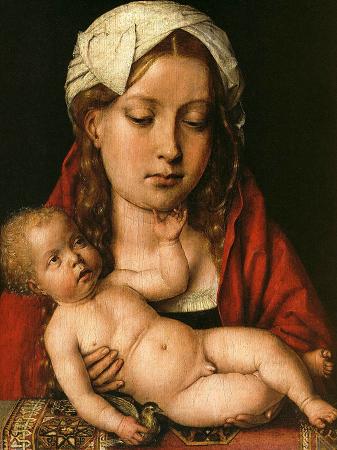Wilton Diptych (c1397). The Wilton Diptych is a small portable diptych of two hinged panels, painted on both sides, now in the National Gallery, London. It is an extremely rare survival of a late Medieval religious panel painting from England. The diptych was painted for King Richard II of England, who is depicted kneeling before the Virgin and Child in what is known as a donor portrait. He is presented to them by his patron saint, John the Baptist, and by the English saints King Edward the Confessor and King Edmund the Martyr. The painting is an outstanding example of the International Gothic style, and the nationality of the unknown artist is probably French or English. The Wilton Diptych is painted on two panels of Baltic oak, set in frames of the same material and joined by two hinges so that it may be closed to protect the inner painting. The inner faces of the panels are in excellent condition for their age, though some glazes have been lost, but the outer faces have paint losses from handling. The painting is in tempera, the ground paint being mixed with egg yolk and laid in thin glazes. The background and many details are inlaid with gold leaf and in places the panel has been tooled beneath the gilding to enhance the decorative quality. In the panel with the Virgin and Christ Child, the garments are universally blue, the pigment coming from the semi-precious stone lapis lazuli. Richard's robe uses vermilion, another expensive pigment. Some colours have faded; the roses in the angels' hair would originally have been a much deeper pink, and the green grass of the outer hart panel is now much darker than when painted. Although the figures of the two inner scenes face each other, and interact by gaze and gesture, they are set in different backgrounds. The human figures are on bare rocky ground, with a forest behind, and a gold leaf sky decorated with a pattern made by a metal punch. The heavenly figures stand in a flowery meadow, behind which is a gold background patterned by a different punch. In the left inner panel the kneeling King Richard II is presented by the Saints John the Baptist, Edward the Confessor and Edmund the Martyr, each holding their attribute. In the right-hand panel the Virgin Mary with the Christ Child in her arms is surrounded by eleven angels, against a golden background and field of delicately coloured flowers. Richard's outer robe is of cloth of gold and red vermilion, the fabric decorated with his personal device of the white harts and sprigs of rosemary, the emblem of his wife Anne of Bohemia, who died in 1394. Around his neck is a gold collar with broomscods, seed-pods of Cytisus scoparius, the common broom, which is the planta genista that gave Richard's Plantagenet dynasty its name. They were also the emblem of Charles VI of France, whose daughter he married in 1396. Richard had been given such a collar by Charles in 1393, and wearing one here may indicate a date for the work after Richard's second marriage to the six-year-old Isabella of Valois in 1396. The livery badges worn by both Richard and the angels appear to be made in the fashionable and expensive technique of ronde bosse white enamel on gold; they are comparable to the surviving Dunstable Swan Jewel, probably given by one of Richard's cousins in the House of Lancaster. Richard's badge, but not those of the angels, has pearls tipping the antlers, and may perhaps be based on one of several examples recorded in his treasure roll of 1397, which had pearls and a bed of emeralds for the hind to sit on. A hart badge of Richard's inventoried in the possession of Duke Philip the Good of Burgundy in 1435 was set with 22 pearls, two spinels, two sapphires, a ruby and a huge diamond. Although thematically linked, the composition of the two pictures is quite different in feeling. The scene of Richard and his patrons is very sedate, but full of rich contrasts in colour and texture. The scene of the Virgin and Child is full of energetic movement created by the angels who encircle the mother and child. The predominant brilliant blue gives a precious quality, symbolising the heavenly nature of this apparition. The flowery ground also symbolises the gardens of Paradise. The strong tonal contrast of the angel's wings throw the figures into relief against the background. When closed, the diptych reveals on one side a white hart or stag, Richard's emblem gorged with a golden coronet around its throat and a golden chain, lodged on a grassy meadow with branches of Anne's rosemary, with a gold sky. On the other is a coat of arms with arms associated with King Edward the Confessor impaled with the arms of the Kings of England. These arms were adopted by Richard in about 1395.
more...




